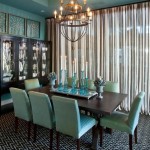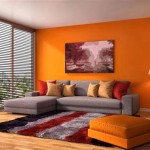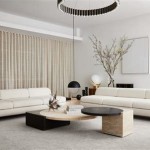How to Leverage Decorating Tips to Transform Your Living Space
Interior decorating plays a vital role in shaping the atmosphere and functionality of a living space. It goes beyond simply filling rooms with furniture; it's about creating an environment that reflects personal style, promotes comfort, and enhances everyday life. Understanding and applying effective decorating tips can empower individuals to transform their homes into aesthetically pleasing and highly functional spaces, regardless of budget or experience level.
This article explores several core decorating tips, providing a comprehensive guide to understanding the principles of design and offering practical advice for implementing them in various rooms and design scenarios. The focus is on providing actionable information that can be easily applied to achieve desired decorating outcomes.
Understanding the Importance of a Cohesive Color Palette
The color palette chosen for a room significantly impacts the overall mood and visual appeal. Selecting a cohesive color scheme is a fundamental aspect of interior decorating. A well-coordinated palette creates a sense of harmony and unity, preventing the space from feeling disjointed or chaotic. There are several established color schemes that can be utilized, including:
Monochromatic: This scheme uses different shades and tints of a single color. For example, a monochromatic blue room might incorporate navy blue accent pillows, light blue walls, and deep cobalt accessories. This approach offers a clean and sophisticated look.
Analogous: This scheme uses colors that are adjacent to each other on the color wheel. An example would be a palette of blue, blue-green, and green. Analogous colors create a harmonious and calming effect.
Complementary: This scheme uses colors that are opposite each other on the color wheel, such as blue and orange, red and green, or yellow and purple. Complementary colors create a high-contrast, vibrant look. Used judiciously, they can add energy and excitement to a space.
Triadic: This scheme uses three colors that are equally spaced on the color wheel. Examples include red, yellow, and blue, or orange, green, and purple. Triadic color schemes are bold and visually stimulating.
When selecting a color palette, it's important to consider the natural lighting in the room and the desired mood. Lighter colors tend to brighten a space and make it feel larger, while darker colors can create a more intimate and cozy atmosphere. Testing paint samples in the room under different lighting conditions is crucial to ensure accurate color representation.
Beyond the wall color, the color palette should extend to furniture, textiles, and accessories. Coordinating these elements helps to create a unified and polished look. The 60-30-10 rule is a helpful guideline: 60% of the room should be the dominant color, 30% should be the secondary color, and 10% should be an accent color. This ratio provides a balanced and visually appealing distribution of color.
Utilizing color psychology is also a valuable tool. Different colors evoke different emotions. For example, blue is often associated with calmness and tranquility, while red is associated with energy and excitement. Choosing colors that align with the intended mood of the room can significantly impact the overall atmosphere.
The Art of Furniture Placement and Space Planning
Effective furniture placement is essential for creating a functional and aesthetically pleasing living space. A well-planned layout maximizes available space, promotes flow, and enhances the overall usability of the room. The following principles should be considered when arranging furniture:
Define the Focal Point: Every room should have a focal point, which is the primary area of visual interest. This could be a fireplace, a large window with a scenic view, an entertainment center, or a statement piece of artwork. Furniture should be arranged to draw attention to and complement the focal point.
Create Conversation Areas: In living rooms and family rooms, furniture should be arranged to facilitate conversation. Arrange seating in a way that allows people to easily interact with each other. A good rule of thumb is to position seating within 8 feet of each other to encourage comfortable conversation.
Maximize Space: Consider the size and shape of the room when selecting furniture. In smaller rooms, opt for smaller-scale furniture and avoid overcrowding the space. Wall-mounted shelves and storage solutions can help to maximize vertical space and minimize clutter.
Consider Traffic Flow: Ensure that furniture placement allows for clear and unobstructed pathways throughout the room. Avoid placing furniture in front of doorways or in areas where people frequently walk. Create a natural flow of movement throughout the space.
Use Area Rugs to Define Zones: Area rugs can be used to define different zones within a room, such as a seating area in a living room or a dining area in an open-concept kitchen. Rugs help to anchor furniture and create a sense of visual separation.
Maintain Balance and Proportion: Strive for a balanced and proportionate arrangement of furniture. Avoid placing all of the heavy furniture on one side of the room, as this can create a sense of imbalance. Mix and match different sizes and shapes of furniture to create visual interest.
Utilize Negative Space: Don't be afraid to leave some empty space in the room. Negative space allows the eye to rest and prevents the space from feeling cluttered. Strategically placed negative space can enhance the overall sense of openness and airiness.
Prior to physically moving furniture, creating a floor plan can be a highly beneficial step. This allows for visualizing different arrangements and experimenting with layouts without the physical effort. Many online tools and software programs are available to assist in creating accurate and detailed floor plans.
The Power of Lighting and Accessories
Lighting and accessories are the finishing touches that add personality, warmth, and depth to a room. They are crucial for creating a layered and inviting atmosphere. Effective use of lighting and accessories can transform a space from functional to extraordinary.
Layer Lighting: A well-lit room incorporates multiple layers of lighting, including ambient lighting, task lighting, and accent lighting. Ambient lighting provides overall illumination, task lighting provides focused light for specific activities, and accent lighting highlights architectural features or artwork. Combining these three types of lighting creates a balanced and versatile lighting scheme.
Consider Bulb Temperature: The color temperature of light bulbs can significantly impact the mood of a room. Warm white light (2700K-3000K) creates a cozy and inviting atmosphere, while cool white light (3500K-4100K) provides a more energizing and focused light. Choose bulb temperatures that align with the intended purpose and mood of the room.
Utilize Natural Light: Maximize the use of natural light by keeping windows clean and unobstructed. Use sheer curtains or blinds to filter harsh sunlight and create a softer, more diffused light. Mirrors can also be used to reflect natural light and brighten a space.
Accessorize with Personality: Accessories are an opportunity to express personal style and add character to a room. Choose accessories that reflect personal interests and passions. This could include artwork, photographs, books, plants, decorative objects, and textiles.
Create Visual Balance: When arranging accessories, strive for visual balance. Avoid placing all of the large accessories on one side of the room. Distribute accessories evenly throughout the space to create a sense of harmony.
Use Textiles to Add Texture and Color: Textiles, such as throw pillows, blankets, curtains, and rugs, can add texture and color to a room. Mix and match different textures and patterns to create visual interest. Consider the season when selecting textiles. Lighter fabrics are suitable for warmer months, while heavier fabrics are appropriate for cooler months.
Incorporate Greenery: Plants add life and vibrancy to a room. They can also help to purify the air and improve indoor air quality. Choose plants that are appropriate for the lighting conditions in the room. Consider using a variety of plant sizes and shapes to create visual interest.
Hang Artwork at Eye Level: Hang artwork at eye level for optimal viewing. The center of the artwork should be approximately 57-60 inches from the floor. If hanging multiple pieces of artwork together, create a cohesive arrangement that is visually appealing.
In conclusion, applying these fundamental decorating tips can empower individuals to transform their living spaces into personalized, functional, and aesthetically pleasing environments. By understanding the principles of color, furniture arrangement, lighting, and accessory selection, anyone can create a home that reflects their unique style and enhances their quality of life.

Pin By Katrinaskitchen On Kitchen Tips How To Piping Frosting Cake Decorating Cupcake

Learn How To Use Piping Tips With This Easy Decorating Tutorial Book Cakes Wilton Cake

Russian Piping Tips How To Use Decorating On Cookies And Cupcakes

How To Use Piping Tips Beyond Frosting

My Favourite Piping Tips Jane S Patisserie

How To Use Round Piping Tips

How To Use Round Piping Tips 101 Guide Wilton S Baking Blog Homemade Cake Other Recipes

Russian Piping Tips How To Use Decorating On Cookies And Cupcakes

Russian Piping Tips How To Use Decorating On Cookies And Cupcakes

Helpful Cupcake Decorating Tip Photo Desserts Cake Tips Cakes
Related Posts







